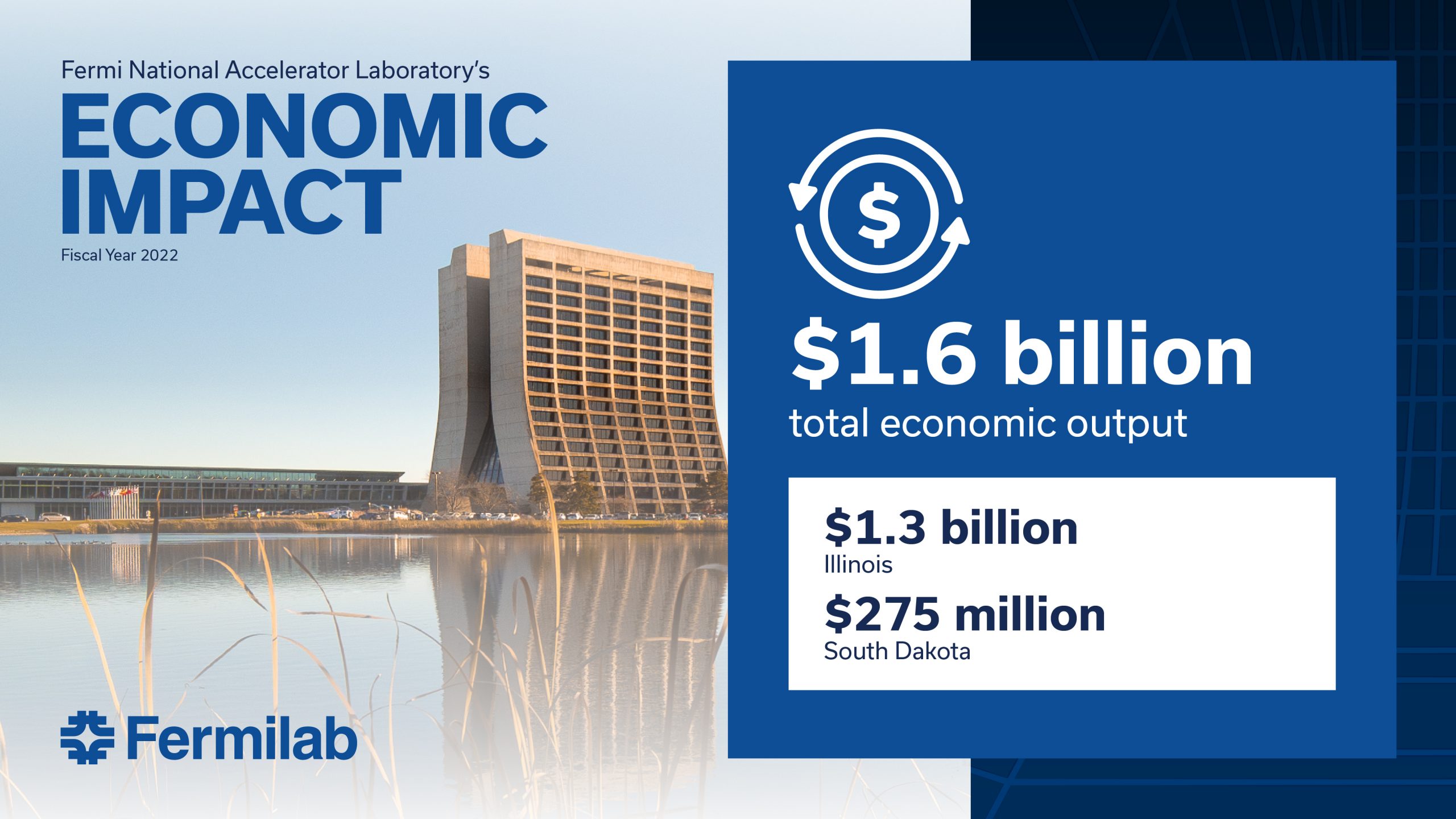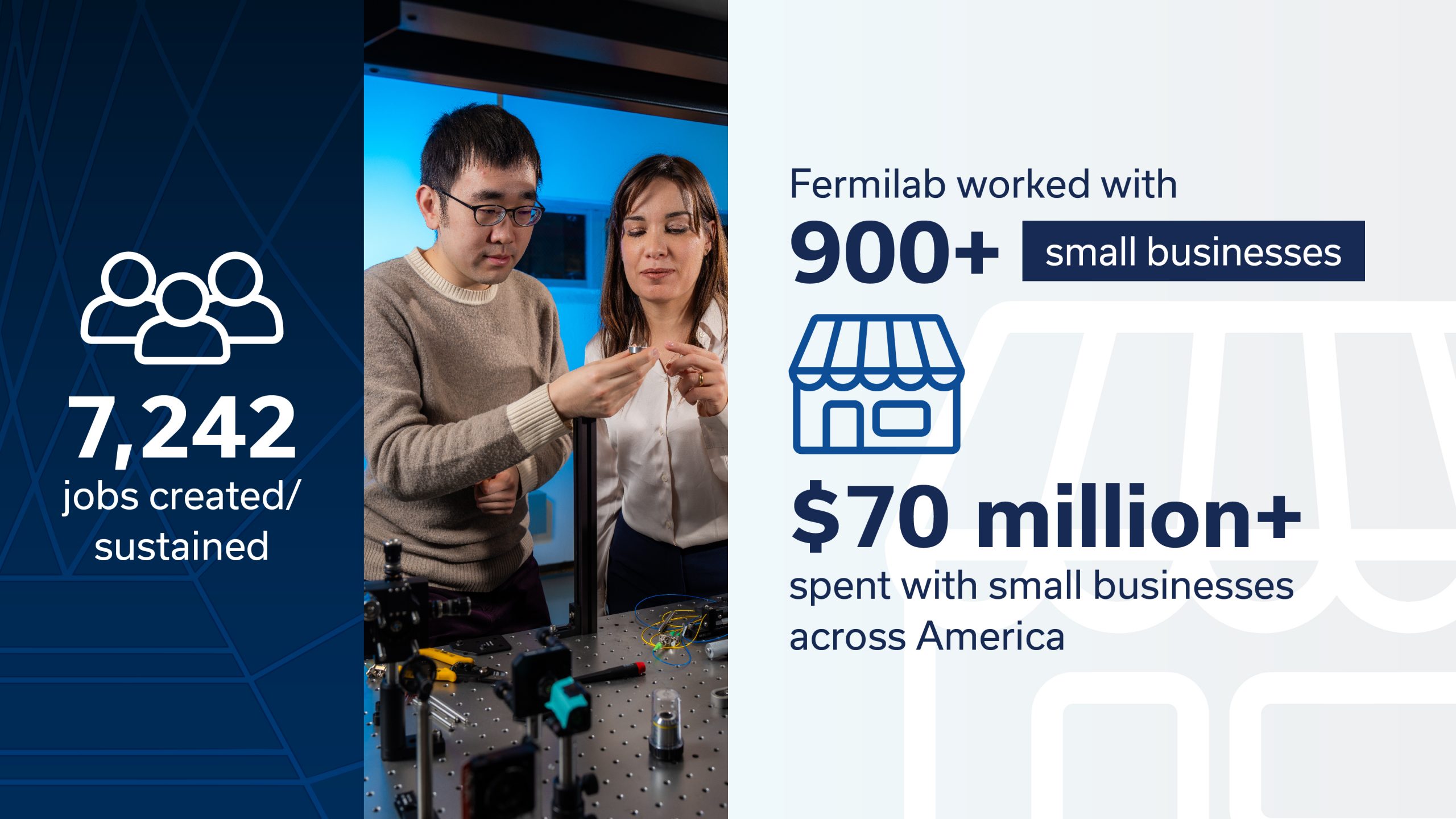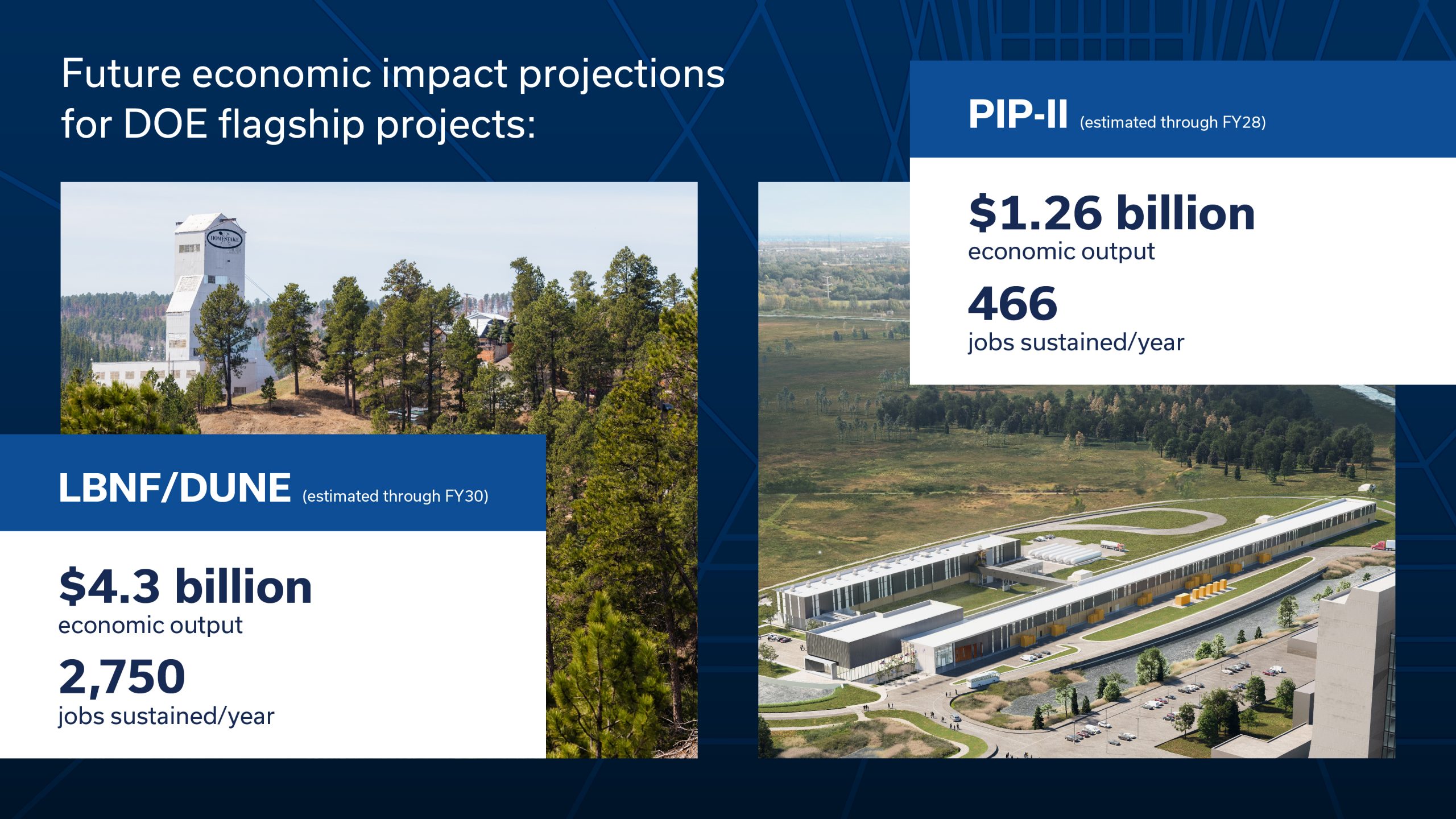An extensive new study reveals the growing positive economic impact of operations conducted by U.S. Department of Energy’s Fermi National Accelerator Laboratory in Illinois and South Dakota, contributing $1.6 billion in economic output in fiscal year 2022 and supporting 7,242 jobs.
The FY22 study shows that Fermilab creates positive direct economic impacts in Illinois and South Dakota, as well as beneficial ripple effects within the states’ economies that spark further business-to-business and consumer spending.
Fermi Research Alliance manages and operates Fermilab on behalf of the U.S. Department of Energy. Fermilab is America’s premier particle physics and accelerator laboratory. Scientists from around the world come to use Fermilab facilities for research into the fundamental building blocks of the universe.
In Fermilab’s home state of Illinois, the study shows spending by the laboratory to be a major contributor to the state’s prosperity. Investments in scientific research and spending on operations added nearly $1.3 billion to the state’s economic output in FY22 and increased total household income in Illinois by $529 million.

The study further shows laboratory spending to be an engine powering employment in Illinois, accounting for the creation and sustainment of over 5,000 jobs within the state. The total includes more than 1,900 employees at the Fermilab site in Batavia and over 3,000 additional people employed to support Fermilab operations and employees.
Illinois businesses increasingly capitalized on procurement spending, receiving 33% of the $286 million in new subcontract awards. Fermilab’s total economic output in Illinois increased by 188%, driven largely by this more than 50% increase in procurement spending.
The state of South Dakota also received significant economic benefits from laboratory investment during FY22 as excavation and engineering activities were underway to expand caverns at the Sanford Underground Research Facility in Lead, South Dakota.
The seven-story tall caverns, completed in January 2024, will eventually hold massive particle detectors for the Long Baseline Neutrino Facility/Deep Underground Neutrino Experiment project at SURF.
The detectors will be part of an ambitious experiment to study neutrinos, particles which may hold the key to understanding why matter exists in the universe.
During FY22, LBNF/DUNE was the Department of Energy’s largest capital asset project. Fermilab spent $150 million that fiscal year creating this unique, world-class facility.
The economic ripple effect of laboratory spending in FY22 generated $275 million in total economic output, created or sustained 1,500 jobs, and increased household income by $98 million in South Dakota.
Of these jobs, about one thousand were directly connected with project operations, more than 200 were indirect jobs created or sustained through hiring subcontractors, and over 300 jobs were induced by spending from project employees.

While the LBNF/DUNE excavation occurred in South Dakota, the study points out many of the staff supporting the project in FY22 were subcontractors and/or were operating remotely from Illinois.
In addition to economic gains through spending on operations, engineering and construction projects, Fermilab attracted more than 5,600 visiting professionals to its sites in Illinois and South Dakota.
Fermilab welcomed over 5,000 visiting professionals —an increase from 2,000 in FY18 — to Illinois during FY22 for collaboration on cutting-edge physics experiments. Visitors included scientists, engineers, computing professionals, students, post-doctoral researchers and businesspeople contributing to sustain a thriving research ecosystem.
According to the study, these visitors came to Fermilab in Illinois at an average rate of 170 per week, and they each stayed in the area an average of six days. Each visitor spent an average of $223.54 per day into the local economy.
South Dakota operations attracted more than 600 visiting professionals from outside the state in FY22. Based on survey responses received, people visiting the SURF site spent an average of $172.56 per day into the local economy.
Additionally, the positive economic effects of laboratory spending created benefits to U.S. states beyond Illinois and South Dakota. The study shows businesses and subcontractors across the country were recipients of lab procurement spending in FY22, receiving a total of about $286 million — an increase from $184 million spent in FY18.
A detailed interactive map of the U.S. on the Fermilab website demonstrates how new procurement dollars were spread across a wide range of states.
Of the subcontractors located across America, over 900 were small businesses that received a total of over $70 million. Illinois small businesses received a significant portion of this money — $41 million — from the lab, showing an increase from $34 million in FY18.
Nationwide, 16% of the lab’s procurement spending went to small and disadvantaged businesses, 12% went to woman-owned businesses, 9% to Historically Underutilized Business Zone businesses, and 5% to veteran-owned small businesses.

Looking to the future, LBNF/DUNE and the related Proton Improvement Plan-II will continue to be flagship projects, driving advancements in high-energy physics and accelerator science for years to come.
When completed, the new PIP-II particle accelerator will provide an initial stream of protons to the LBNF beam line that will in turn generate the high-intensity beam of neutrinos sent to the DUNE particle detectors.
Spending on PIP-II is forecast to continue through FY28, peaking during FY24—FY25. The total economic output from FY22 to completion in FY28 will generate $1.26 billion in Illinois. During this period the average per-year contributions to the Illinois gross state product will be $70.7 million, with 466 jobs created or sustained annually in Illinois.
Construction-related spending for the LBNF/DUNE project is expected to positively impact economies through FY30. Project-related economic output from LBNF/DUNE is expected to peak during the FY25—FY28 period at $542.9 million annually. Annual employment generated or sustained by LBNF/DUNE is projected to peak during FY25—FY28 with 3,192 jobs.
This study, which assessed the FY22 economic data, used an updated modeling approach to fully capture the extent of economic benefits derived from laboratory operations. Fermilab consulted with other laboratories within the DOE laboratory complex and utilized expertise from Idaho National Laboratory to design and run economic modeling using IMPLAN software.
The software uses a modeling technique called input-output analysis to show how economic activity creates a ripple effect that leads to further economic activity.
This approach captures highly accurate data applicable to the geographic regions in which the laboratory operates and transitions Fermilab to a method of reporting on economic activity that aligns with national laboratory and industry standards.
Fermilab is America’s premier national laboratory for particle physics and accelerator research. A U.S. Department of Energy Office of Science laboratory, Fermilab is located near Chicago, Illinois, and operated under contract by the Fermi Research Alliance LLC. Visit Fermilab’s website at www.fnal.gov and follow us on Twitter at @Fermilab.
The DOE Office of Science is the single largest supporter of basic research in the physical sciences in the United States and is working to address some of the most pressing challenges of our time. For more information, please visit science.energy.gov.
